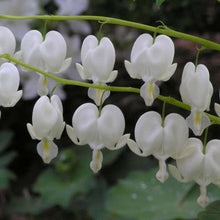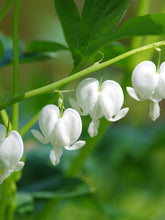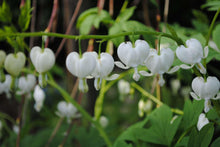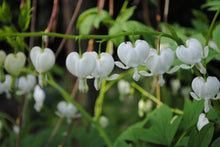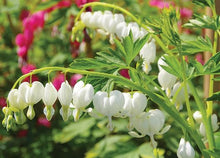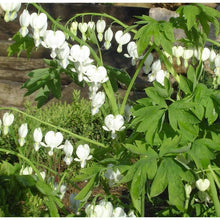
Dicentra spectabilis Alba, now called Lamprocapnos spectabilis, or more commonly referred to as either the bleeding heart plant or the "Lady in the Bath". It bears white, heart-shaped flowers with white tips, which hang from arching flower stems in late spring to early summer. Although it grows in light shade and looks good growing in clumps amongst shrubs, it often does even better in a sunny border, provided the soil stays sufficiently moist.
It is native to Siberia, northern China, Korea, and Japan.
• Planting period: February to May, September to November
• Planting depth: 6-8 cm
• Planting density: 5 per m²
• Exposure: partial sun, dappled shade, full sun
• Soil: Moist, well-drained
• Soil type: Acidic / chalky / alkaline / sandy
• Attracts Hummingbirds
• Can be planted in: Borders and beds, rock gardens; woodlands
• Does well as a cut flower for bouquets
• Rabbit Resistant
• Naturalizes easily
• Height at maturity: 60 cm
• Spread at maturity: 45 cm
• Hardiness level: Hardy, can be kept in the ground over winter
• Plant care: Needs regular watering in pots
• Precautions: NOT DOG SAFE
• Dormancy: Summer
• Pruning: Once a year in the summer after flowering has ended
• Difficulty: Easy
It can remain in the ground for many years and does not need dividing, fortunately, because they have brittle roots and do not like disturbance – instead, try taking root cuttings in spring. The Royal Horticultural Society has given it its prestigious Award of Garden Merit (AGM).
Care advice
If your soil is too poor or too sandy, you can add a good layer of dead leaves in autumn, which will enrich and soften your beds after a few years. Avoid synthetic fertilizers that only enrich the soil in the short term.
Weekly watering is recommended throughout the first year, during the warm season, to promote recovery. Stop watering when the leaves turn yellow and disappear.
The tender leaves are also rather sensitive to slugs and snails in the beginning of growth. Place ashes, eggshells or, failing that, granules that can be used in organic farming, without danger for animals that consume gastropods, around the stump






